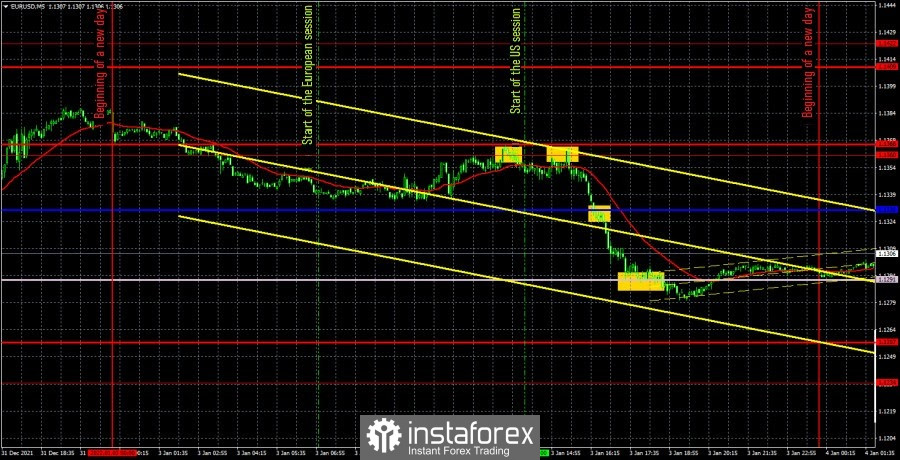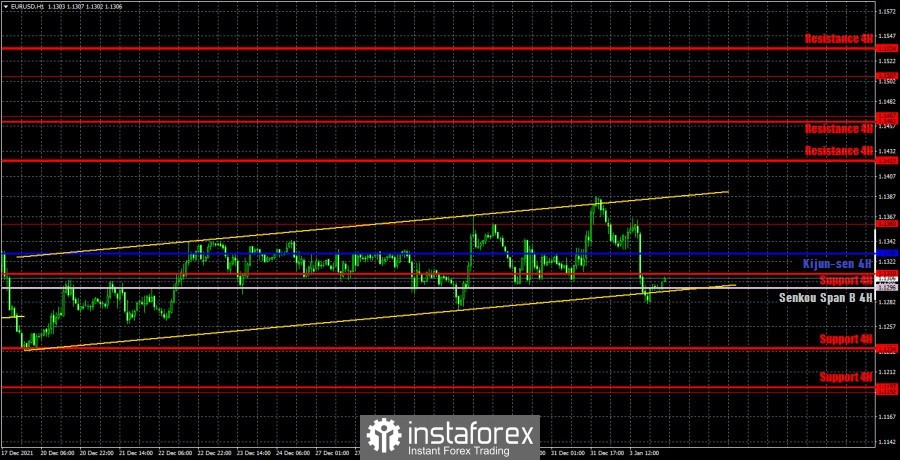EUR/USD 5M

The EUR/USD pair was trading quite actively during the first trading day of the week, especially for the 5-minute timeframe. The volatility of the day was more than 100 points, so it was possible and necessary to trade the pair. It turns out that the year began immediately with active movement, without long swaying. Quite good signals were generated in the same way. However, before we start examining them, it should be noted that important macroeconomic statistics were not published on Monday, either in the US or in the European Union. There were only indices of business activity in the manufacturing sectors of both countries, which, however, did not cause any reaction from traders. And it is not surprising that their values practically did not differ from the predicted ones. Thus, on January 3, traders could only trade using technical signals. The movement was rather weak during the European trading session. The bears did not manage to push the pair to the critical line, so no buy signal was formed. But bulls were able to reach the extremum level of 1.1360 (formerly 1.1355) and failed to overcome it twice. The pair bounced off this level twice, forming sell signals. Traders could open short positions in both cases, but duplication, of course, was not worth it. Those who opened positions after the first signal after the second should not have done it. As a result, the pair began a rather powerful fall in the US trading session and by the end of the day found itself near the Senkou Span B line, which by that time was at the level of 1.1291. On the way, the Kijun-sen line was crossed, near which another sell signal was formed. But traders just had to stay in short positions here. Thus, in the late afternoon, this single deal should have been closed. There was no clear rebound from the Senkou Span B line, so the shorts had to be manually eliminated. The profit was about 55 points. Nice start to the year.
We recommend you to familiarize yourself:
Overview of the EUR/USD pair. December 31. Traders started preparing for the New Year back in November.
Overview of the GBP/USD pair. December 31. The pound is waiting for another fun year.
Forecast and trading signals for GBP/USD for December 31. Detailed analysis of the movement of the pair and trade deals.
EUR/USD 1H

An upward trend channel was formed on the hourly timeframe on the last day of the outgoing year. It has a very formal meaning, since in the last month the pair was more within the 1.1234-1.1355 horizontal channel. But still, at the end of the year, the pair managed to gain a foothold slightly above the level of 1.1355, so now a marginal upward trend has formed, which can be broken today, since the pair managed to fall by 80 points on the first trading day of 2022. In general, only a rebound from the Senkou Span B line and the lower border of this channel can save the euro from the beginning of a new downward trend. We highlight the following levels for trading on Tuesday - 1.1192, 1.1234, 1.1360, 1.1422, as well as the Senkou Span B (1.1296) and Kijun-sen (1.1330) lines. The Ichimoku indicator lines can change their position during the day, which should be taken into account when looking for trading signals. Signals can be "rebounds" and "breakthroughs" of these levels and lines. Do not forget about placing a Stop Loss order at breakeven if the price moves 15 points in the right direction. This will protect you against possible losses if the signal turns out to be false. Today, the United States will publish the index of business activity in the ISM manufacturing sector for December. This is not the most significant indicator, but it can still provoke some movement in the pair. Traders are now showing that they are ready to trade without a "foundation" and "macroeconomics".
Explanations for the chart:
Support and Resistance Levels are the levels that serve as targets when buying or selling the pair. You can place Take Profit near these levels.
Kijun-sen and Senkou Span B lines are lines of the Ichimoku indicator transferred to the hourly timeframe from the 4-hour one.
Support and resistance areas are areas from which the price has repeatedly rebounded off.
Yellow lines are trend lines, trend channels and any other technical patterns.
Indicator 1 on the COT charts is the size of the net position of each category of traders.
Indicator 2 on the COT charts is the size of the net position for the non-commercial group.






















